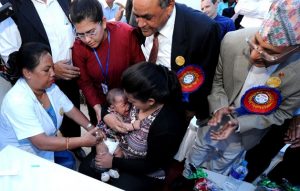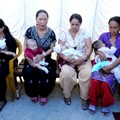Historic IPV Introduction in Nepal
Nepal becomes first GAVI eligible country to introduce vaccine

This week, Nepal became the first GAVI-eligible country to introduce the inactivated polio vaccine (IPV) into its routine immunization programme. This landmark distinguishes Nepal as a forerunner in global efforts to eradicate polio and in preventing a resurgence of the disease.
As the first children were given a dose of the vaccine, the Nepalese Health Minister Khaga Raj Adhikari said: “The last transmission of polio from one person to another in Nepal was almost five years ago. Today, we start to make sure that not one of our children will ever again have her future stolen or his dreams destroyed by this disease.”
The launch in Nepal is a historic landmark in efforts to secure a lasting polio-free world, in particular in preparation for the phased removal of oral polio vaccines (OPVs) as outlined in the Global Polio Eradication Initiative (GPEI) Polio Eradication and Endgame Strategic Plan 2013-2018 (the Endgame Plan).
Today’s introduction of IPV as part of the routine immunization schedule in Nepal is part of the worldwide roll-out of the vaccine across 126 countries by the end of 2015 – one of the largest and fastest globally-coordinated vaccine introduction projects in history. Nepal is the first GAVI-eligible country to introduce the new vaccine, out of 53 of the poorest countries in the world. This move to strengthen immunization systems by Nepal’s Ministry of Health and Population is an important step in ensuring that children, no matter where they are born, will never again suffer from this debilitating disease.
Until recently, OPV has been the primary tool used in the global polio eradication effort. The ease with which OPV can be administered enabled an army of volunteers to join the movement that has worked tirelessly to eradicate the disease, protecting children without extensive training. The impact of OPV has been dramatic, preventing more than 10 million cases of polio in the past decade and reducing disease incidence by more than 99% since 1988 when the GPEI was launched.
The Endgame Plan calls on all countries that currently use only OPV to introduce at least one dose of IPV into their routine immunization schedules by end-2015. This is in advance of the full change- over which will occur once wild poliovirus transmission has stopped globally. To stimulate immunity, OPV contains attenuated (weakened) polioviruses. On extremely rare occasions, the use of OPV can result in cases of polio due to vaccine-associated paralytic polio (VAPP) and circulating vaccine-derived polioviruses (cVDPVs). This only occurs when population immunity is very low, or when children are suffering from malnutrition, making it more a factor of poverty than of the vaccine itself. Until now, the benefits of OPV use have far outweighed any small, associated risks.
Now that polio eradication is within reach and fewer cases of polio are reported, a new plan has been devised to minimise the risks of OPV while still achieving the global eradication goal. New evidence now clearly demonstrates that adding one dose of IPV to multiple doses of OPV at 14 weeks is the most effective method available to stop the virus and protect children, boosting immunity more effectively than just more doses of OPV.
The World Health Organization continues to work in close coordination with the GAVI Alliance, UNICEF, the Centre for Disease Control, Rotary International and other partners, in supporting countries in this effort. As of mid-2014, 72 countries are already using IPV, 49 countries have made a formal commitment to introduce and an additional 35 had declared intent to introduce IPV in their routine immunization programme by end-2015. These countries account for approximately 96% of the global birth cohort.
The poliovirus is now only endemic in three countries worldwide: Afghanistan, Nigeria and Pakistan, with outbreaks in the Horn of Africa, central Africa and the Middle East. With the global eradication effort being closer than ever to stopping this disease in its tracks, these steps towards the endgame have a major global significance.














